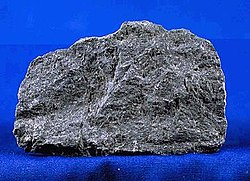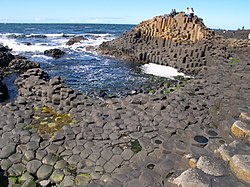Basalt

Basalt is a common grey to black rock. It is pushed out (extruded) by volcanos. The lava is rich in magnesium and iron.
It has olivine and pyroxene minerals which make it dark in colour. Basalt is usually fine-grained because the lava cools rapidly on the Earth's surface. Flood basalts are commonplace, formed by lava pouring out and solidifying.
On Earth, most basalt magmas have formed by the hot molten mantle. Basalt is a type of intrusive rock meaning it forms inside of the volcano. Basalt has also formed on Earth's Moon, Mars, Venus, and even on the asteroid Vesta.
The crustal portions of oceanic tectonic plates are made mostly of basalt, produced from upwelling mantle below mid-ocean ridges.
Unweathered basalt is black or grey. Basalt blocks are often used for roads and pavements (sidewalks), and for houses and other buildings. It is hard-wearing and heat resistant.
Basalt can be made into fibre. Basalt fibre is often used as a safe replacement for asbestos. Intense heat and pressure can change basalt into its metamorphic rock equivalent. The rocks known as greenstone are basalt which has been metamorphised. See metamorphic rock for more details.
+{{{1}}}−{{{2}}}
Basalt Media
QAPF diagram with basalt/andesite field highlighted in yellow. Basalt is distinguished from andesite by SiO2
Basalt is field B in the TAS classification.
Vesicular basalt at Sunset Crater, Arizona. US quarter (24mm) for scale.
Large masses must cool slowly to form a polygonal joint pattern, as here at the Giant's Causeway in Northern Ireland
Columns of basalt near Bazaltove, Ukraine
Photomicrograph of a thin section of basalt from Bazaltove, Ukraine
The Giant's Causeway in Northern Ireland











